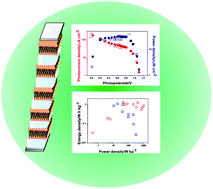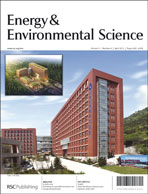A lightweight, autonomous and practical, proof-of-concept electrical power source is developed within this work. It comprises a photoredox-active material embedded within the non-ionic surfactant subphase, with a second redox reagent present within the aqueous pseudophase of a lamellar (Lα) lyotropic liquid crystal framework, which is sandwiched between two electrodes, one of which acts in a sacrificial manner. This quasi-biphasic, entirely new-concept, electrochemical cell, based on electron transfer, rather than ion transfer, is shown to act as a photogalvanic device which, under violet light, is demonstrated to exhibit maximum light-to-electrical power conversion efficiency of ca. 2% (fill factor of 15%), with additional ability to act as an electrically-rechargeable electrochemical capacitor of voltage efficiency ∼85% and power efficiency ∼80%, and with estimated maximum energy density of ∼1 W h kg−1 at a power density of ∼1 kW kg−1.
You have access to this article
 Please wait while we load your content...
Something went wrong. Try again?
Please wait while we load your content...
Something went wrong. Try again?


 Please wait while we load your content...
Please wait while we load your content...